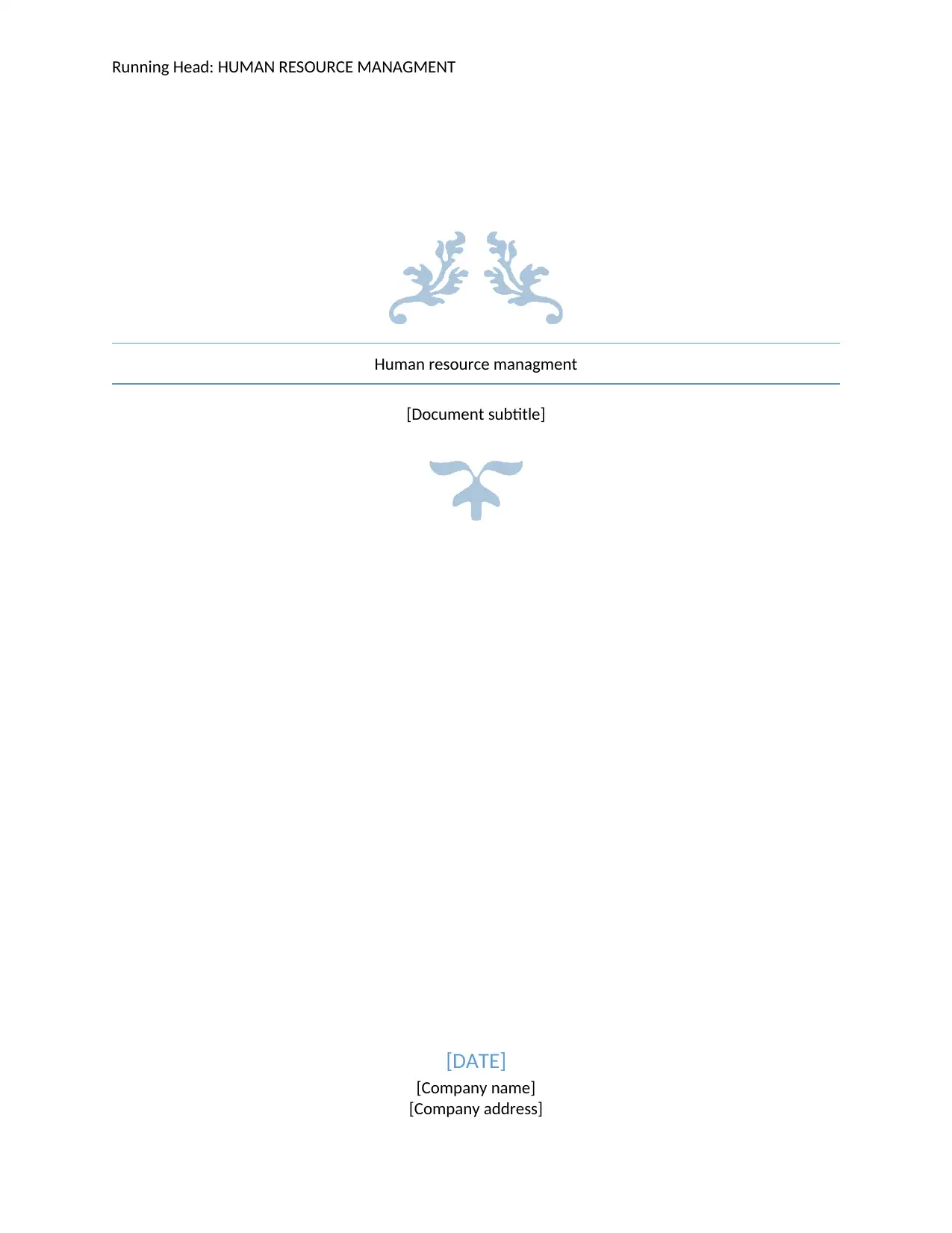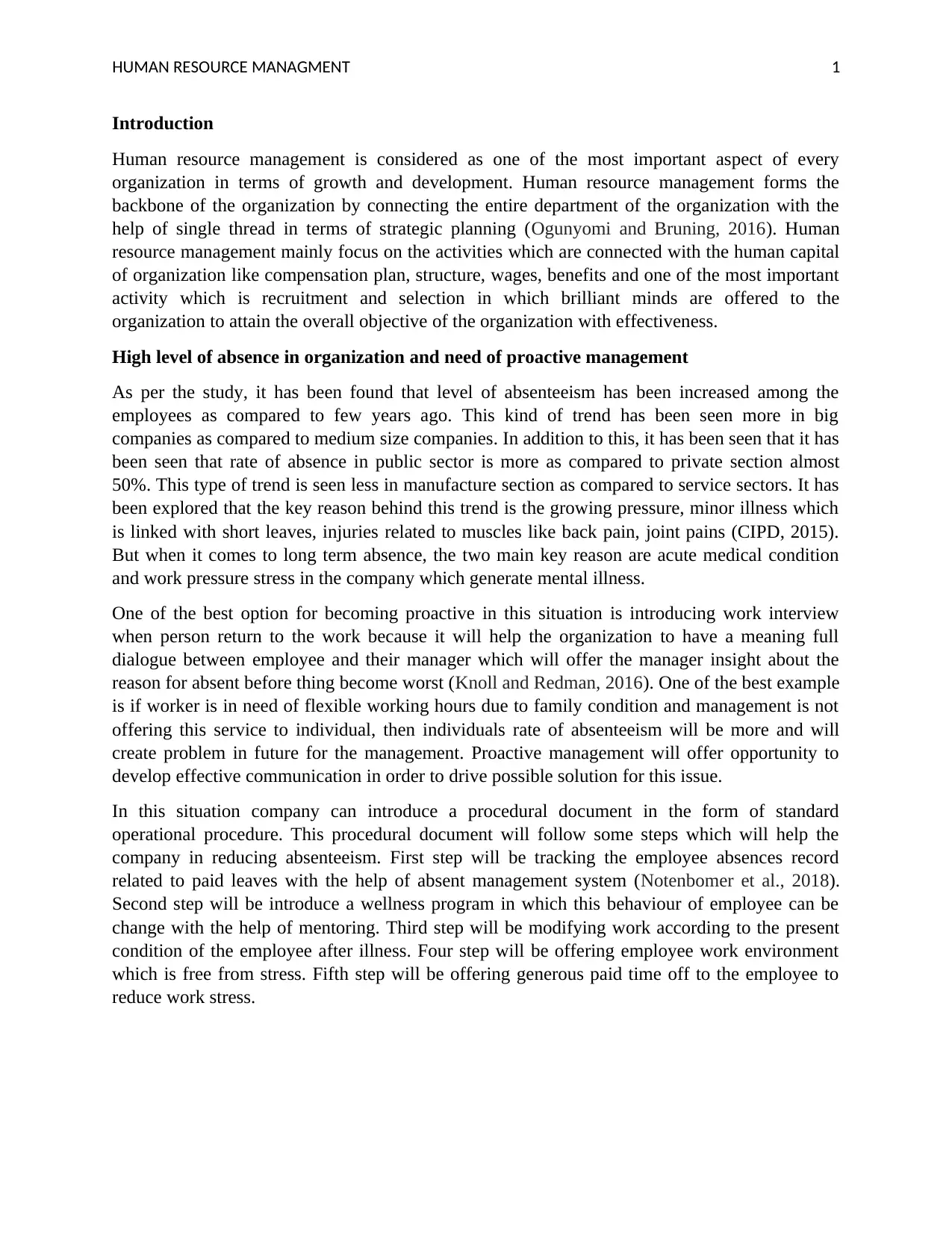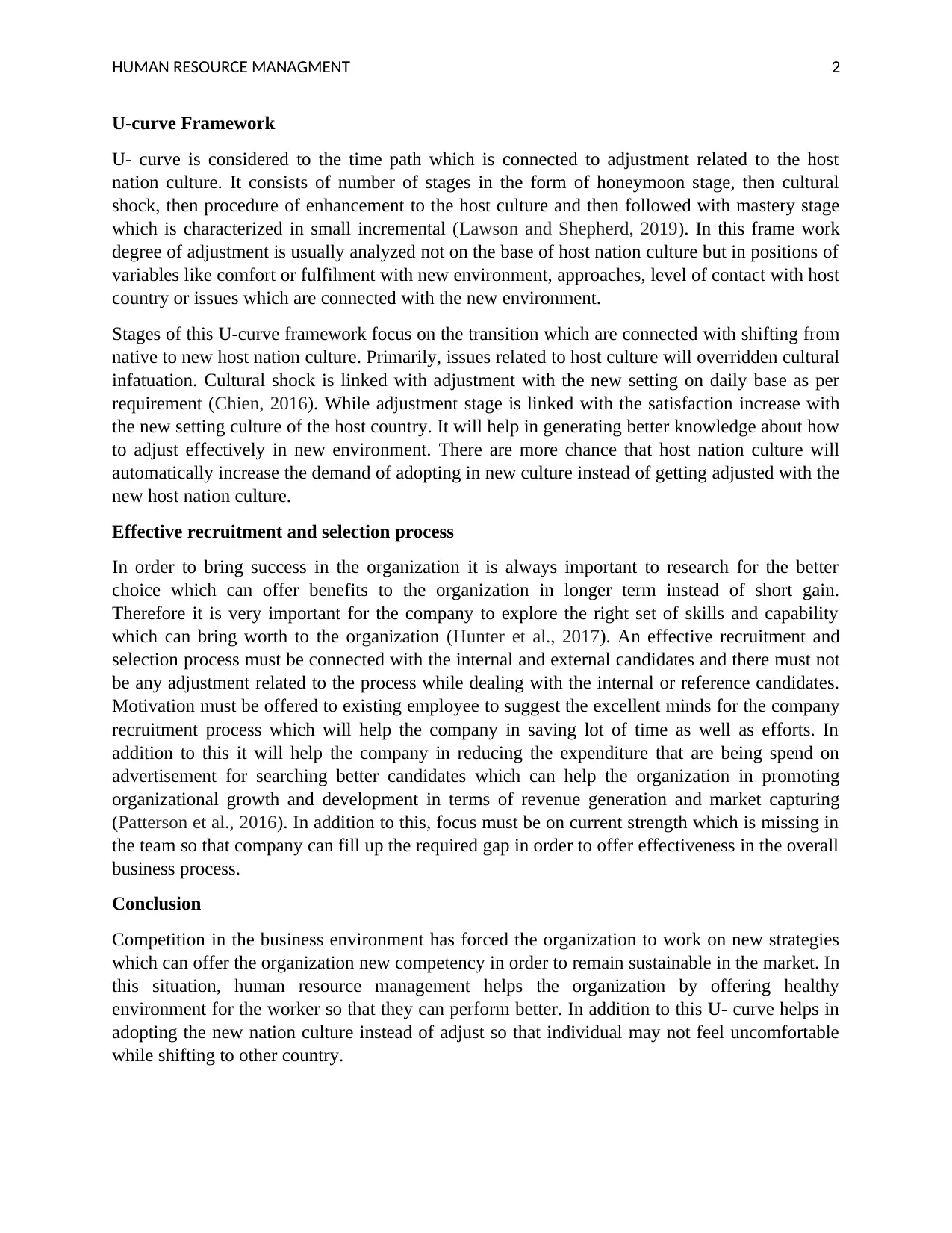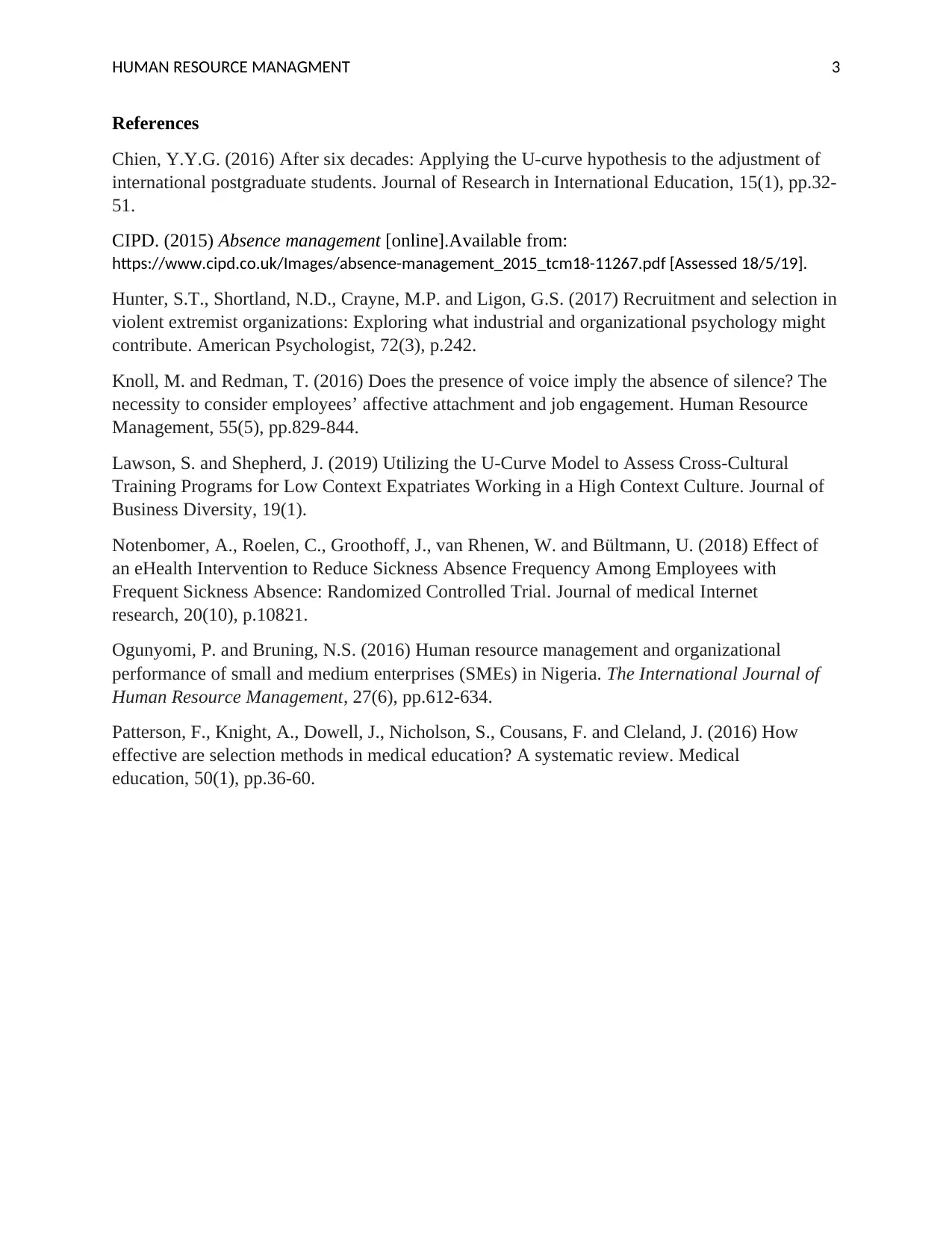Human Resource Management: Absence, U-Curve & Recruitment Analysis
VerifiedAdded on 2022/11/14
|4
|1475
|3
Essay
AI Summary
This essay explores key aspects of human resource management, focusing on strategies to address employee absenteeism and enhance organizational performance. It highlights the rising levels of absenteeism, particularly in larger and public sector organizations, attributing it to factors like work pressure and minor illnesses. The essay suggests proactive management strategies, including return-to-work interviews and wellness programs, to mitigate absenteeism. It also discusses the U-curve framework for understanding cultural adjustment and emphasizes the importance of effective recruitment and selection processes to ensure long-term organizational success. The conclusion stresses the need for organizations to adopt new strategies to remain competitive, with human resource management playing a crucial role in fostering a healthy work environment.

Running Head: HUMAN RESOURCE MANAGMENT
Human resource managment
[Document subtitle]
[DATE]
[Company name]
[Company address]
Human resource managment
[Document subtitle]
[DATE]
[Company name]
[Company address]
Paraphrase This Document
Need a fresh take? Get an instant paraphrase of this document with our AI Paraphraser

HUMAN RESOURCE MANAGMENT 1
Introduction
Human resource management is considered as one of the most important aspect of every
organization in terms of growth and development. Human resource management forms the
backbone of the organization by connecting the entire department of the organization with the
help of single thread in terms of strategic planning (Ogunyomi and Bruning, 2016). Human
resource management mainly focus on the activities which are connected with the human capital
of organization like compensation plan, structure, wages, benefits and one of the most important
activity which is recruitment and selection in which brilliant minds are offered to the
organization to attain the overall objective of the organization with effectiveness.
High level of absence in organization and need of proactive management
As per the study, it has been found that level of absenteeism has been increased among the
employees as compared to few years ago. This kind of trend has been seen more in big
companies as compared to medium size companies. In addition to this, it has been seen that it has
been seen that rate of absence in public sector is more as compared to private section almost
50%. This type of trend is seen less in manufacture section as compared to service sectors. It has
been explored that the key reason behind this trend is the growing pressure, minor illness which
is linked with short leaves, injuries related to muscles like back pain, joint pains (CIPD, 2015).
But when it comes to long term absence, the two main key reason are acute medical condition
and work pressure stress in the company which generate mental illness.
One of the best option for becoming proactive in this situation is introducing work interview
when person return to the work because it will help the organization to have a meaning full
dialogue between employee and their manager which will offer the manager insight about the
reason for absent before thing become worst (Knoll and Redman, 2016). One of the best example
is if worker is in need of flexible working hours due to family condition and management is not
offering this service to individual, then individuals rate of absenteeism will be more and will
create problem in future for the management. Proactive management will offer opportunity to
develop effective communication in order to drive possible solution for this issue.
In this situation company can introduce a procedural document in the form of standard
operational procedure. This procedural document will follow some steps which will help the
company in reducing absenteeism. First step will be tracking the employee absences record
related to paid leaves with the help of absent management system (Notenbomer et al., 2018).
Second step will be introduce a wellness program in which this behaviour of employee can be
change with the help of mentoring. Third step will be modifying work according to the present
condition of the employee after illness. Four step will be offering employee work environment
which is free from stress. Fifth step will be offering generous paid time off to the employee to
reduce work stress.
Introduction
Human resource management is considered as one of the most important aspect of every
organization in terms of growth and development. Human resource management forms the
backbone of the organization by connecting the entire department of the organization with the
help of single thread in terms of strategic planning (Ogunyomi and Bruning, 2016). Human
resource management mainly focus on the activities which are connected with the human capital
of organization like compensation plan, structure, wages, benefits and one of the most important
activity which is recruitment and selection in which brilliant minds are offered to the
organization to attain the overall objective of the organization with effectiveness.
High level of absence in organization and need of proactive management
As per the study, it has been found that level of absenteeism has been increased among the
employees as compared to few years ago. This kind of trend has been seen more in big
companies as compared to medium size companies. In addition to this, it has been seen that it has
been seen that rate of absence in public sector is more as compared to private section almost
50%. This type of trend is seen less in manufacture section as compared to service sectors. It has
been explored that the key reason behind this trend is the growing pressure, minor illness which
is linked with short leaves, injuries related to muscles like back pain, joint pains (CIPD, 2015).
But when it comes to long term absence, the two main key reason are acute medical condition
and work pressure stress in the company which generate mental illness.
One of the best option for becoming proactive in this situation is introducing work interview
when person return to the work because it will help the organization to have a meaning full
dialogue between employee and their manager which will offer the manager insight about the
reason for absent before thing become worst (Knoll and Redman, 2016). One of the best example
is if worker is in need of flexible working hours due to family condition and management is not
offering this service to individual, then individuals rate of absenteeism will be more and will
create problem in future for the management. Proactive management will offer opportunity to
develop effective communication in order to drive possible solution for this issue.
In this situation company can introduce a procedural document in the form of standard
operational procedure. This procedural document will follow some steps which will help the
company in reducing absenteeism. First step will be tracking the employee absences record
related to paid leaves with the help of absent management system (Notenbomer et al., 2018).
Second step will be introduce a wellness program in which this behaviour of employee can be
change with the help of mentoring. Third step will be modifying work according to the present
condition of the employee after illness. Four step will be offering employee work environment
which is free from stress. Fifth step will be offering generous paid time off to the employee to
reduce work stress.

HUMAN RESOURCE MANAGMENT 2
U-curve Framework
U- curve is considered to the time path which is connected to adjustment related to the host
nation culture. It consists of number of stages in the form of honeymoon stage, then cultural
shock, then procedure of enhancement to the host culture and then followed with mastery stage
which is characterized in small incremental (Lawson and Shepherd, 2019). In this frame work
degree of adjustment is usually analyzed not on the base of host nation culture but in positions of
variables like comfort or fulfilment with new environment, approaches, level of contact with host
country or issues which are connected with the new environment.
Stages of this U-curve framework focus on the transition which are connected with shifting from
native to new host nation culture. Primarily, issues related to host culture will overridden cultural
infatuation. Cultural shock is linked with adjustment with the new setting on daily base as per
requirement (Chien, 2016). While adjustment stage is linked with the satisfaction increase with
the new setting culture of the host country. It will help in generating better knowledge about how
to adjust effectively in new environment. There are more chance that host nation culture will
automatically increase the demand of adopting in new culture instead of getting adjusted with the
new host nation culture.
Effective recruitment and selection process
In order to bring success in the organization it is always important to research for the better
choice which can offer benefits to the organization in longer term instead of short gain.
Therefore it is very important for the company to explore the right set of skills and capability
which can bring worth to the organization (Hunter et al., 2017). An effective recruitment and
selection process must be connected with the internal and external candidates and there must not
be any adjustment related to the process while dealing with the internal or reference candidates.
Motivation must be offered to existing employee to suggest the excellent minds for the company
recruitment process which will help the company in saving lot of time as well as efforts. In
addition to this it will help the company in reducing the expenditure that are being spend on
advertisement for searching better candidates which can help the organization in promoting
organizational growth and development in terms of revenue generation and market capturing
(Patterson et al., 2016). In addition to this, focus must be on current strength which is missing in
the team so that company can fill up the required gap in order to offer effectiveness in the overall
business process.
Conclusion
Competition in the business environment has forced the organization to work on new strategies
which can offer the organization new competency in order to remain sustainable in the market. In
this situation, human resource management helps the organization by offering healthy
environment for the worker so that they can perform better. In addition to this U- curve helps in
adopting the new nation culture instead of adjust so that individual may not feel uncomfortable
while shifting to other country.
U-curve Framework
U- curve is considered to the time path which is connected to adjustment related to the host
nation culture. It consists of number of stages in the form of honeymoon stage, then cultural
shock, then procedure of enhancement to the host culture and then followed with mastery stage
which is characterized in small incremental (Lawson and Shepherd, 2019). In this frame work
degree of adjustment is usually analyzed not on the base of host nation culture but in positions of
variables like comfort or fulfilment with new environment, approaches, level of contact with host
country or issues which are connected with the new environment.
Stages of this U-curve framework focus on the transition which are connected with shifting from
native to new host nation culture. Primarily, issues related to host culture will overridden cultural
infatuation. Cultural shock is linked with adjustment with the new setting on daily base as per
requirement (Chien, 2016). While adjustment stage is linked with the satisfaction increase with
the new setting culture of the host country. It will help in generating better knowledge about how
to adjust effectively in new environment. There are more chance that host nation culture will
automatically increase the demand of adopting in new culture instead of getting adjusted with the
new host nation culture.
Effective recruitment and selection process
In order to bring success in the organization it is always important to research for the better
choice which can offer benefits to the organization in longer term instead of short gain.
Therefore it is very important for the company to explore the right set of skills and capability
which can bring worth to the organization (Hunter et al., 2017). An effective recruitment and
selection process must be connected with the internal and external candidates and there must not
be any adjustment related to the process while dealing with the internal or reference candidates.
Motivation must be offered to existing employee to suggest the excellent minds for the company
recruitment process which will help the company in saving lot of time as well as efforts. In
addition to this it will help the company in reducing the expenditure that are being spend on
advertisement for searching better candidates which can help the organization in promoting
organizational growth and development in terms of revenue generation and market capturing
(Patterson et al., 2016). In addition to this, focus must be on current strength which is missing in
the team so that company can fill up the required gap in order to offer effectiveness in the overall
business process.
Conclusion
Competition in the business environment has forced the organization to work on new strategies
which can offer the organization new competency in order to remain sustainable in the market. In
this situation, human resource management helps the organization by offering healthy
environment for the worker so that they can perform better. In addition to this U- curve helps in
adopting the new nation culture instead of adjust so that individual may not feel uncomfortable
while shifting to other country.
⊘ This is a preview!⊘
Do you want full access?
Subscribe today to unlock all pages.

Trusted by 1+ million students worldwide

HUMAN RESOURCE MANAGMENT 3
References
Chien, Y.Y.G. (2016) After six decades: Applying the U-curve hypothesis to the adjustment of
international postgraduate students. Journal of Research in International Education, 15(1), pp.32-
51.
CIPD. (2015) Absence management [online].Available from:
https://www.cipd.co.uk/Images/absence-management_2015_tcm18-11267.pdf [Assessed 18/5/19].
Hunter, S.T., Shortland, N.D., Crayne, M.P. and Ligon, G.S. (2017) Recruitment and selection in
violent extremist organizations: Exploring what industrial and organizational psychology might
contribute. American Psychologist, 72(3), p.242.
Knoll, M. and Redman, T. (2016) Does the presence of voice imply the absence of silence? The
necessity to consider employees’ affective attachment and job engagement. Human Resource
Management, 55(5), pp.829-844.
Lawson, S. and Shepherd, J. (2019) Utilizing the U-Curve Model to Assess Cross-Cultural
Training Programs for Low Context Expatriates Working in a High Context Culture. Journal of
Business Diversity, 19(1).
Notenbomer, A., Roelen, C., Groothoff, J., van Rhenen, W. and Bültmann, U. (2018) Effect of
an eHealth Intervention to Reduce Sickness Absence Frequency Among Employees with
Frequent Sickness Absence: Randomized Controlled Trial. Journal of medical Internet
research, 20(10), p.10821.
Ogunyomi, P. and Bruning, N.S. (2016) Human resource management and organizational
performance of small and medium enterprises (SMEs) in Nigeria. The International Journal of
Human Resource Management, 27(6), pp.612-634.
Patterson, F., Knight, A., Dowell, J., Nicholson, S., Cousans, F. and Cleland, J. (2016) How
effective are selection methods in medical education? A systematic review. Medical
education, 50(1), pp.36-60.
References
Chien, Y.Y.G. (2016) After six decades: Applying the U-curve hypothesis to the adjustment of
international postgraduate students. Journal of Research in International Education, 15(1), pp.32-
51.
CIPD. (2015) Absence management [online].Available from:
https://www.cipd.co.uk/Images/absence-management_2015_tcm18-11267.pdf [Assessed 18/5/19].
Hunter, S.T., Shortland, N.D., Crayne, M.P. and Ligon, G.S. (2017) Recruitment and selection in
violent extremist organizations: Exploring what industrial and organizational psychology might
contribute. American Psychologist, 72(3), p.242.
Knoll, M. and Redman, T. (2016) Does the presence of voice imply the absence of silence? The
necessity to consider employees’ affective attachment and job engagement. Human Resource
Management, 55(5), pp.829-844.
Lawson, S. and Shepherd, J. (2019) Utilizing the U-Curve Model to Assess Cross-Cultural
Training Programs for Low Context Expatriates Working in a High Context Culture. Journal of
Business Diversity, 19(1).
Notenbomer, A., Roelen, C., Groothoff, J., van Rhenen, W. and Bültmann, U. (2018) Effect of
an eHealth Intervention to Reduce Sickness Absence Frequency Among Employees with
Frequent Sickness Absence: Randomized Controlled Trial. Journal of medical Internet
research, 20(10), p.10821.
Ogunyomi, P. and Bruning, N.S. (2016) Human resource management and organizational
performance of small and medium enterprises (SMEs) in Nigeria. The International Journal of
Human Resource Management, 27(6), pp.612-634.
Patterson, F., Knight, A., Dowell, J., Nicholson, S., Cousans, F. and Cleland, J. (2016) How
effective are selection methods in medical education? A systematic review. Medical
education, 50(1), pp.36-60.
1 out of 4
Related Documents
Your All-in-One AI-Powered Toolkit for Academic Success.
+13062052269
info@desklib.com
Available 24*7 on WhatsApp / Email
![[object Object]](/_next/static/media/star-bottom.7253800d.svg)
Unlock your academic potential
Copyright © 2020–2025 A2Z Services. All Rights Reserved. Developed and managed by ZUCOL.





